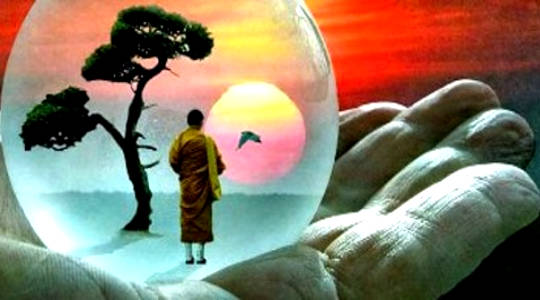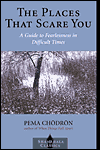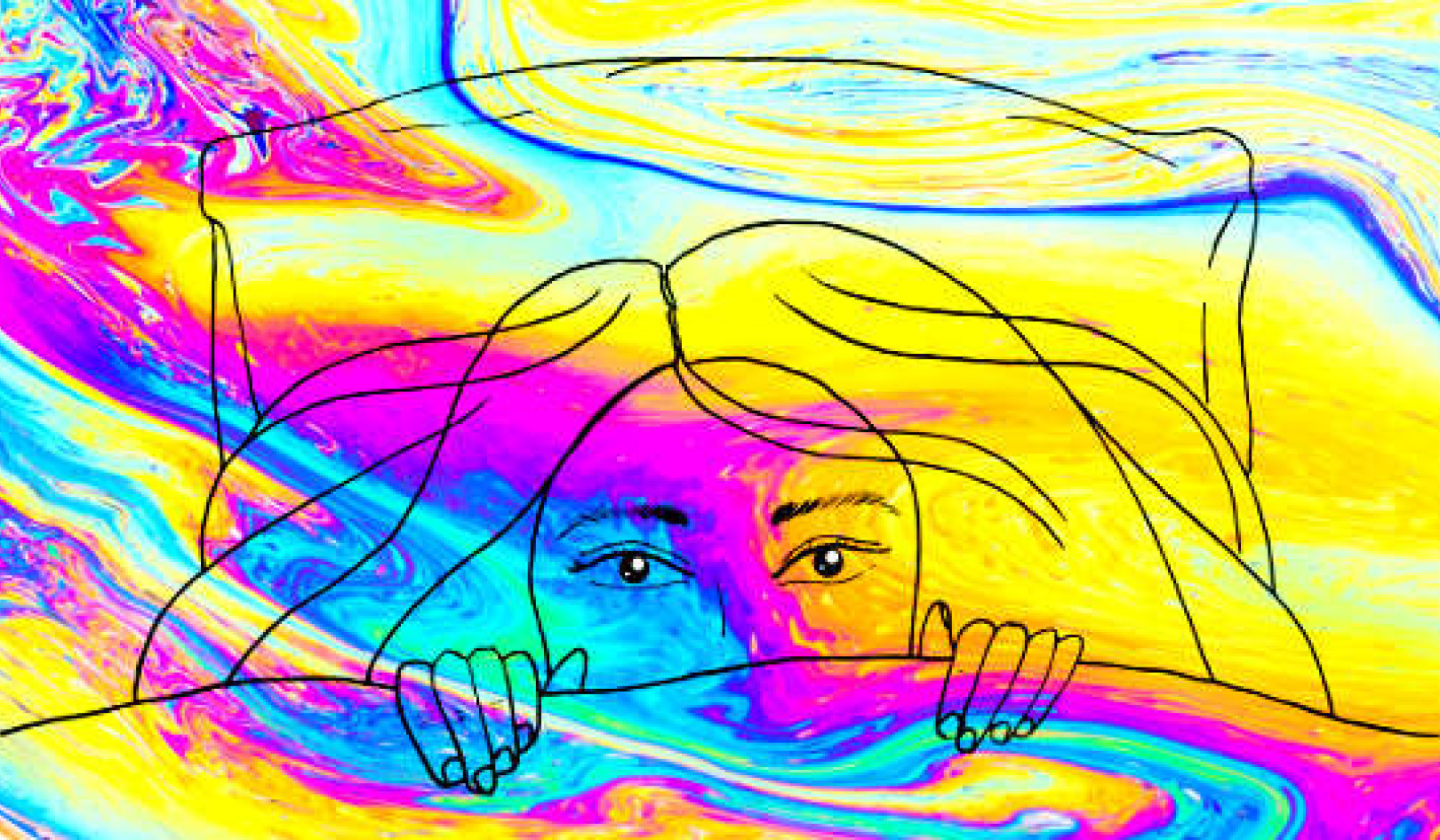
The secret of Zen is just two words:
not always so.
-- SHUNRYU SUZUKI ROSHI
It takes some training to equate complete letting go with comfort. But in fact, "nothing to hold on to" is the root of happiness. There's a sense of freedom when we accept that we're not in control. Pointing ourselves toward what we would most like to avoid makes our barriers and shields permeable.
This may lead to a don't-know-what-to-do kind of feeling, a sense of being caught in-between. On the one hand, we're completely fed up with seeking comfort from what we can eat, drink, smoke, or couple with. We're also fed up with beliefs, ideas, and "isms" of all kinds. But on the other hand we wish it were true that outer comfort could bring lasting happiness.
This in-between state is where the warrior spends a lot of time growing up. We'd give anything to have the comfort we used to get from eating a pizza or watching a video. However, even though those things can be pleasurable, we've seen that eating a pizza or watching a video is a feeble match for our suffering. We notice this especially when things are falling apart. If we've just learned that we have cancer, eating a pizza doesn't do much to cheer us up. If someone we love has just died or walked out, the outer places we go for comfort feel feeble and ephemeral.
Chasing After Pleasure & Running From Pain
We are told about the pain of chasing after pleasure and the futility of running from pain. We hear also about the joy of awakening, of realizing our interconnectedness, of trusting the openness of our hearts and minds. But we aren't told all that much about this state of being in-between, no longer able to get our old comfort from the outside but not yet dwelling in a continual sense of equanimity and warmth.
Anxiety, heartbreak, and tenderness mark the in-between state. It's the kind of place we usually want to avoid. The challenge is to stay in the middle rather than buy into struggle and complaint. The challenge is to let it soften us rather than make us more rigid and afraid. Becoming intimate with the queasy feeling of being in the middle of nowhere only makes our hearts more tender. When we are brave enough to stay in the middle, compassion arises spontaneously. By not knowing, not hoping to know, and not acting like we know what's happening, we begin to access our inner strength.
Yet it seems reasonable to want some kind of relief. If we can make the situation right or wrong, if we can pin it down in any way, then we are on familiar ground. But something has shaken up our habitual patterns and frequently they no longer work. Staying with volatile energy gradually becomes more comfortable than acting it out or repressing it. This open-ended tender place is called bodhichitta. Staying with it is what heals. It allows us to let go of our self-importance. It's how the warrior learns to love.
Training to Keep Opening Our Heart
 This is exactly how we're training every time we sit in meditation. We see what comes up, acknowledge that with kindness, and let go. Thoughts and emotions rise and fall. Some are more convincing than others. Habitually we are so uncomfortable with that churned-up feeling that we'd do anything to make it go away. Instead we kindly encourage ourselves to stay with our agitated energy by returning to the breath. This is the basic training that we need to just keep going forward, to just keep opening our heart.
This is exactly how we're training every time we sit in meditation. We see what comes up, acknowledge that with kindness, and let go. Thoughts and emotions rise and fall. Some are more convincing than others. Habitually we are so uncomfortable with that churned-up feeling that we'd do anything to make it go away. Instead we kindly encourage ourselves to stay with our agitated energy by returning to the breath. This is the basic training that we need to just keep going forward, to just keep opening our heart.
Dwelling in the in-between state requires learning to contain the paradox of something's being both right and wrong, of someone's being strong and loving and also angry, uptight, and stingy. In that painful moment when we don't live up to our own standards, do we condemn ourselves or truly appreciate the paradox of being human? Can we forgive ourselves and stay in touch with our good and tender heart? When someone pushes our buttons, do we set out to make the person wrong? Or do we repress our reaction with "I'm supposed to be loving. How could I hold this negative thought?" Our practice is to stay with the uneasiness and not solidify into a view. We can meditate, or simply look at the open sky -- anything that encourages us to stay on the brink and not solidify into a view.
When we find ourselves in a place of discomfort and fear, when we're in a dispute, when the doctor says we need tests to see what's wrong, we'll find that we want to blame, to take sides, to stand our ground. We feel we must have some resolution. We want to hold our familiar view. For the warrior, "right" is as extreme a view as "wrong." They both block our innate wisdom. We stand at the crossroads not knowing which way to go. The crossroads is an important place in the training of a warrior. It's where our solid views begin to dissolve.
Holding the paradox is not something any of us will suddenly be able to do. That's why we're encouraged to spend our whole lives training with uncertainty, ambiguity, insecurity. To stay in the middle prepares us to meet the unknown without fear; it prepares us to face both our life and our death. The in-between state -- where moment by moment the warrior finds himself learning to let go -- is the perfect training ground. It really doesn't matter if we feel depressed about that or inspired. There is absolutely no way to do this just right. That's why compassion, along with courage, are vital: they give us the resources to be genuine about where we are, but at the same time to know that we are always in transition, that the only time is now, and that the future is completely unpredictable and open.
Evolving Beyond the Little Me
As we continue to train, we evolve beyond the little me who continually seeks zones of comfort. We gradually discover that we are big enough to hold something that is neither lie nor truth, neither pure nor impure, neither bad nor good. But first we have to appreciate the richness of the groundless state and hang in there.
It's important to hear about this in-between state. Otherwise we think the warrior's journey is one way or the other; either we're all caught up or we're free. The fact is that we spend a long time in the middle. This juicy spot is a fruitful place to be. Resting here completely -- steadfastly experiencing the clarity of the present moment -- is called enlightenment.
Reprinted with permission of the publisher,
Shambhala Publications, Inc. ©2001. www.shambhala.com
Article Source
The Places That Scare You: A Guide to Fearlessness in Difficult Times
by Pema Chodron.
 We always have a choice in how we react to the circumstances of our lives. We can let them harden us and make us increasingly resentful and afraid, or we can let them soften us and allow our inherent human kindness to shine through. Here Pema Chödrön provides essential tools for dealing with the many difficulties that life throws our way, teaching us how to awaken our basic human goodness and connect deeply with others—to accept ourselves and everything around us complete with faults and imperfections. She shows the strength that comes from staying in touch with what’s happening in our lives right now and helps us unmask the ways in which our egos cause us to resist life as it is. If we go to the places that scare us, Pema suggests, we just might find the boundless life we’ve always dreamed of.
We always have a choice in how we react to the circumstances of our lives. We can let them harden us and make us increasingly resentful and afraid, or we can let them soften us and allow our inherent human kindness to shine through. Here Pema Chödrön provides essential tools for dealing with the many difficulties that life throws our way, teaching us how to awaken our basic human goodness and connect deeply with others—to accept ourselves and everything around us complete with faults and imperfections. She shows the strength that comes from staying in touch with what’s happening in our lives right now and helps us unmask the ways in which our egos cause us to resist life as it is. If we go to the places that scare us, Pema suggests, we just might find the boundless life we’ve always dreamed of.
Click here for more info and/or to order this book.
About the Author
 PEMA CHODRON is an American Buddhist nun and one of the foremost students of Chogyam Trungpa, the renowned Tibetan meditation master. She is the author of The Wisdom of No Escape, Start Where You Are, and the best-selling When Things Fall Apart. She is the resident teacher at Gampo Abbey, Cape Breton, Nova Scotia, in Canada, the first Tibetan monastery for Westerners.
PEMA CHODRON is an American Buddhist nun and one of the foremost students of Chogyam Trungpa, the renowned Tibetan meditation master. She is the author of The Wisdom of No Escape, Start Where You Are, and the best-selling When Things Fall Apart. She is the resident teacher at Gampo Abbey, Cape Breton, Nova Scotia, in Canada, the first Tibetan monastery for Westerners.




























